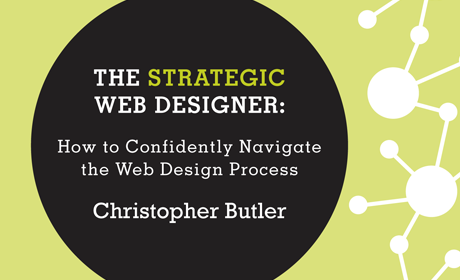The Strategic Web Designer: A Review

I wish it was as simple as saying, “Go buy this book!”. Done and done. If you are a web designer and you care about your work, shouldn't you be reading every book you find about your field? Yes! Well… Sort of. If you have learned anything at all from working with the web, you know that there is a wealth of information at your fingertips. An overabundance even. And it is this overabundance that I will try to overcome in order to tell you why this book, out of the sea of many, belongs on your shelf.
Let me start by addressing something staring you right in the face—this page. I have made three previous attempts at running a blog or a blog-like section of my site to no avail. I would get busy, get distracted, get overwhelmed, get disappointed, and, eventually, get frustrated and shut it down. Christopher Butler, in his article Developing An Effective Content Strategy, revived my desire to write for my web site (I read it in 2011). His articles are knowledgeable, backed by research and experience. The voice, tone, and language of his writing make it easy to follow (and hard to put down).
The Strategic Web Designer covers a wide range of considerations for the discipline of web design. Let's do an overview of it's contents.
Butler begins by considering the question of “What Is the Web?” and giving a bit of history on how it came to be. He invites you to think about it as a medium, how it is different from any other medium, and to remember that it is a permanent work in progress.
If you didn't read any other part of this book, Chapter 2: Planning Web Projects is the one you should read. Most web projects, as Butler points out, go awry in the planning stage. The overall workflow is discussed, from prototype to build to launch. Potential pitfalls are highlighted and some ground rules are suggested to help along the way (of particular interest is the arrangement of build phases).

We are reminded that Your Website Is Not for You. Butler warns of project narcissism, advocating the development of web personas and usability tests in order to gain perspective on how the user may interact with the website.
Planning is revisited by going more in depth on the Information Architecture via site maps, wireframes, and prototypes. As a web site is an interactive experience, Butler argues heavily for the use of prototypes. The language, sequence and structure of prototypes are outlined as well as how they lend themselves to the design of navigation systems, subpage templates and the positioning of elements on the page.
The “magic” of Search Engine Optimization (SEO) is covered in Optimizing Content for Searchers. We learn a bit about how Google works as well as specifics of "On Page" optimization. The abuses of SEO are also addressed, pointing out that every system has its flaws.
You can expect to find a strong case for using analytics and Making Sense of the Data. Measurement, bounce rate, and referrals are discussed in detail, offering suggestions on customized reporting to better understand conversions (or the lack thereof) and what to do about referral traffic.
If Chapter 2 is the one you should read if you didn't read anything else, then Chapter 7: Content is the chapter you have to make time for. Without content, there is no site. Butler is passionate about content strategy—if you have not been converted to the Content Marketing mindset, you will be by the end of this chapter.
No book on web design in the world of 2012 would be complete without discussing The Mobile Web. The mandatory discussions of Apps vs. Web and Responsive Web Design are covered, with the business aspects taken into account as well as the design aspects.
If you are wondering where the Web is going, nobody really knows for sure. But The Web of Tomorrow makes a great attempt at pulling everything into perspective, looking at the history of communication from the written language, to the Gutenberg press, to the radio, to the internet.

The Strategic Web Designer is a wonderfully written book with facts that are substantiated by multiple respected sources in the industry and opinion that is based on professional experience. There is no expectation of the experience level of the reader other than being a professional in the field. This book will be a welcome addition to your personal library.
Note: If you need a sampling of Christopher Butler's work, you should check out his articles at Newfangled Web Developers.
Cheers!
